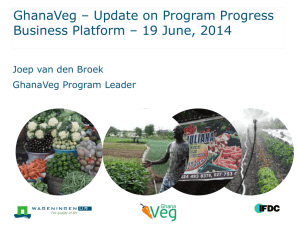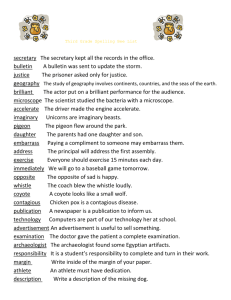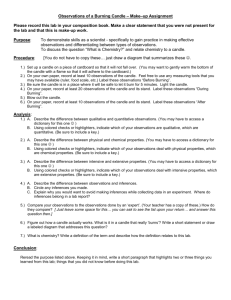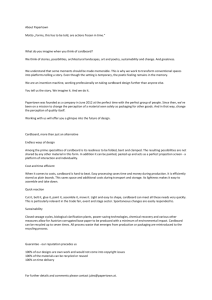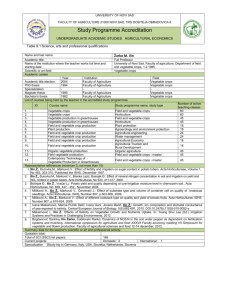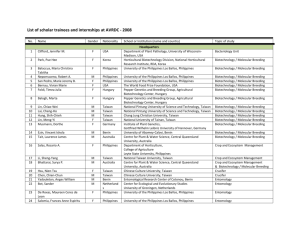Heat Engine- Investigations in Convection Currents
advertisement
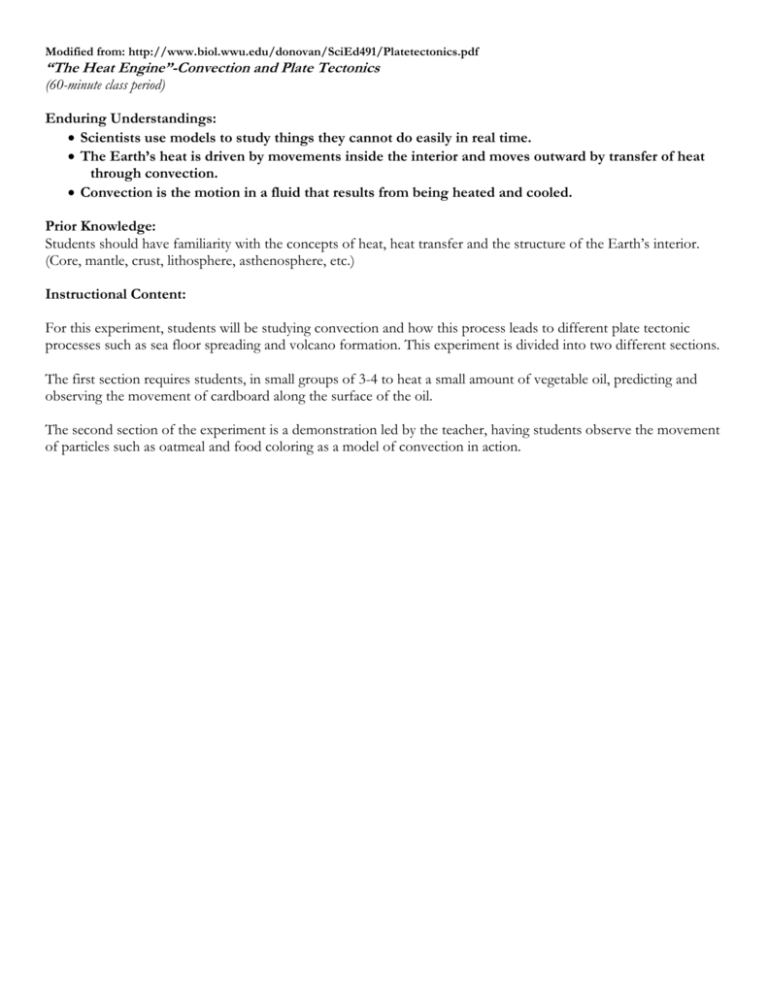
Modified from: http://www.biol.wwu.edu/donovan/SciEd491/Platetectonics.pdf “The Heat Engine”-Convection and Plate Tectonics (60-minute class period) Enduring Understandings: Scientists use models to study things they cannot do easily in real time. The Earth’s heat is driven by movements inside the interior and moves outward by transfer of heat through convection. Convection is the motion in a fluid that results from being heated and cooled. Prior Knowledge: Students should have familiarity with the concepts of heat, heat transfer and the structure of the Earth’s interior. (Core, mantle, crust, lithosphere, asthenosphere, etc.) Instructional Content: For this experiment, students will be studying convection and how this process leads to different plate tectonic processes such as sea floor spreading and volcano formation. This experiment is divided into two different sections. The first section requires students, in small groups of 3-4 to heat a small amount of vegetable oil, predicting and observing the movement of cardboard along the surface of the oil. The second section of the experiment is a demonstration led by the teacher, having students observe the movement of particles such as oatmeal and food coloring as a model of convection in action. Plate Tectonics: The Heat Engine Convection Currents Demonstration Pre-Activity Prediction/Brainstorming: In the space below, make a claim about how heat is moved in the Earth’s interior. What reason can you provide to support your claim - why do you think this? _____________________________________________________________________________ _____________________________________________________________________________ _____________________________________________________________________________ _____________________________________________________________________________ PART ONE: Materials List (one for each student group): Vegetable oil Cardboard scraps Empty flat bottomed, heatable container (i.e. tuna can, Pyrex) Two bricks Candle Matches Graduated cylinder Investigation: 1. Set up the experiment as follows: a) Place 2 bricks several inches apart, placing the candle between the bricks. Place the tuna can on top of the bricks, directly above the candle (when you light the candle, the flame should reach the tuna can), as demonstrated in picture below. You could also use ring stands and Bunsen burners if available. c) Place 25mL of vegetable into the tuna can. d) Light the candle. e) Place two 1 inch pieces of cardboard in the vegetable oil so they are touching each other. 2. While the candle is heating the vegetable oil, predict what you think will happen to the cardboard as the vegetable oil heats up. a) Make a claim- what do you think will happen to the squares when the oil starts to heat? _____________________________________________________________________________ _____________________________________________________________________________ 3. Watch the vegetable oil carefully as it heats up. a) Below, draw a model of what the cardboard is doing when the vegetable oil heats up. Using arrows, show the direction of movement of the vegetable oil. Make a claim: What type of heat transfer caused what you saw? _____________________________________________________________________________ _____________________________________________________________________________ State your evidence: What observations support your claim? _____________________________________________________________________________ _____________________________________________________________________________ _____________________________________________________________________________ _____________________________________________________________________________ PART TWO Materials List (one per teacher for demonstration): 3- 100mL beakers 210mL of water Heat source (hot plate, bunser burner apparatus, etc.) Red food coloring 500mg oatmeal 500ng of sawdust Other options: rice, sprinkles, confetti Investigation: 1. Fill three heat proof 100mL beakers with 70mL of water and place beakers onto hot plates. 2. Make a hypothesis about the question – “What will happen when you add each of the materials to heated water?” (i.e. If I add sawdust to a beaker of water, then ______________, because________________.) 3. When the water is simmering (not boiling), add the following materials to each of the beakers: Beaker Number Material 1 500mg oatmeal 2 5 drops red food coloring 3 500mg sawdust 4. Record your observations as a drawing in the beakers below: Make a claim: How do your models in the beaker compare to the Earth’s interior? _____________________________________________________________________________ _____________________________________________________________________________ What’s your evidence: What did you see that can support your claim? _____________________________________________________________________________ _____________________________________________________________________________ What reasons can you give for what you saw happen? _____________________________________________________________________________ _____________________________________________________________________________ _____________________________________________________________________________ _____________________________________________________________________________ 6. Conclusion Refer to your claim in your prediction. You stated what kind of heat transfer drives the movement of the Earth’s interior. Evaluate your claim and modify if necessary. Now give evidence from the models created that support your claims. _____________________________________________________________________________ _____________________________________________________________________________ _____________________________________________________________________________ _____________________________________________________________________________ _____________________________________________________________________________ _____________________________________________________________________________ _____________________________________________________________________________ _____________________________________________________________________________



